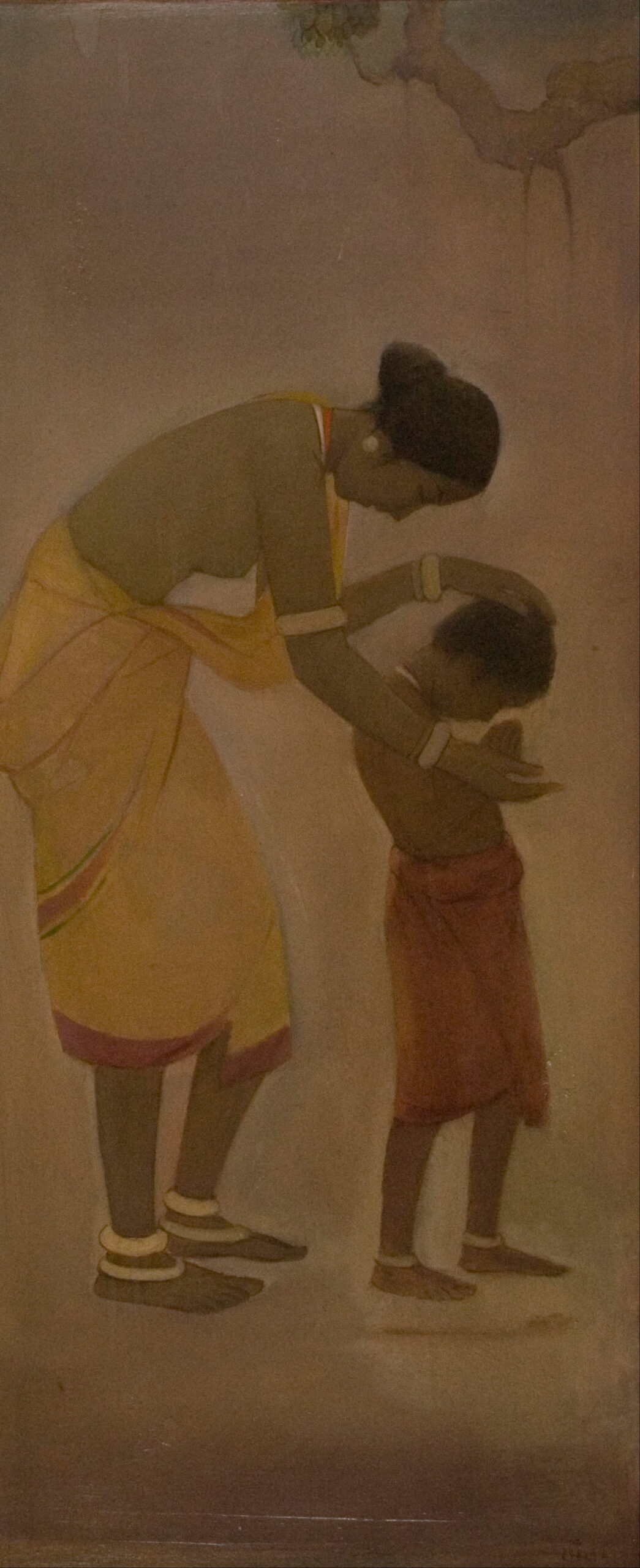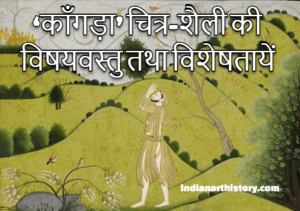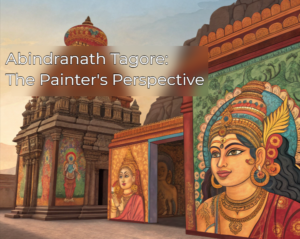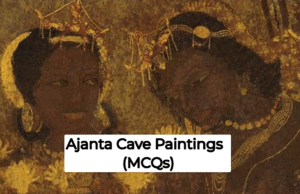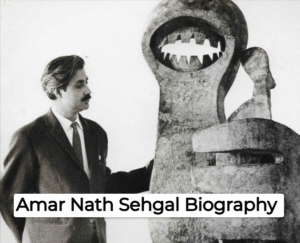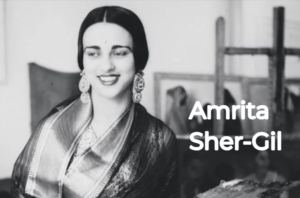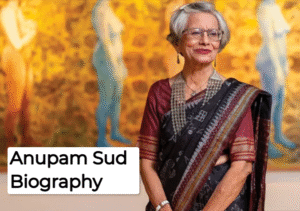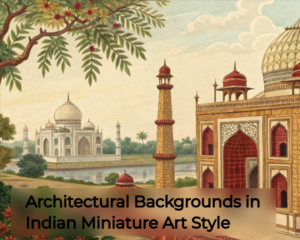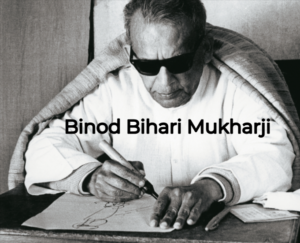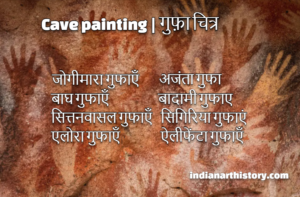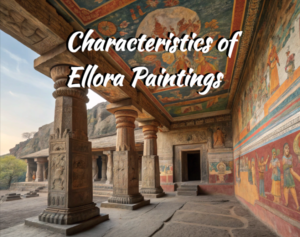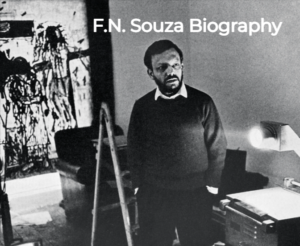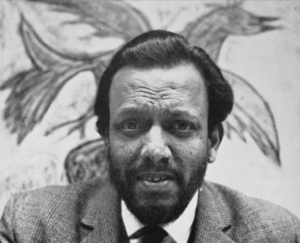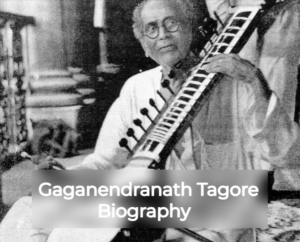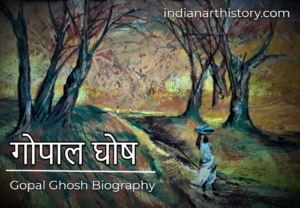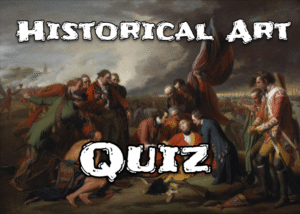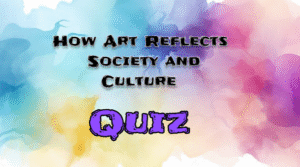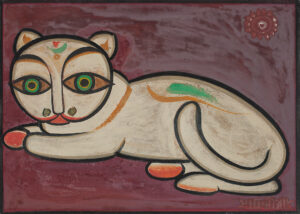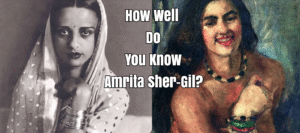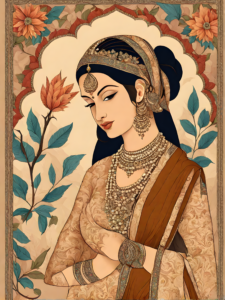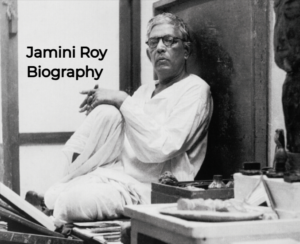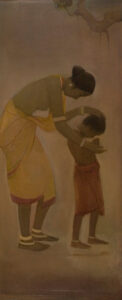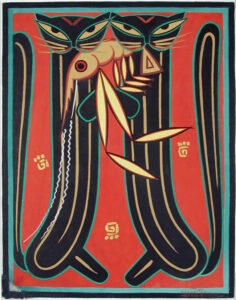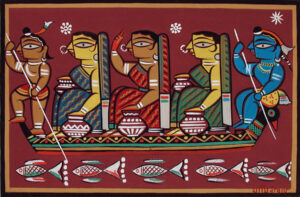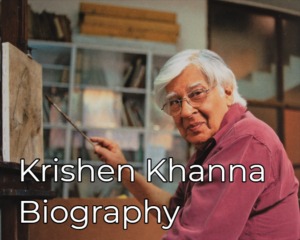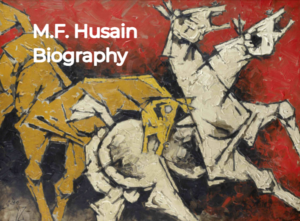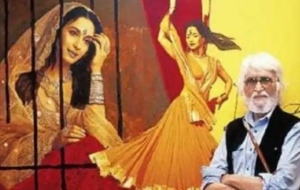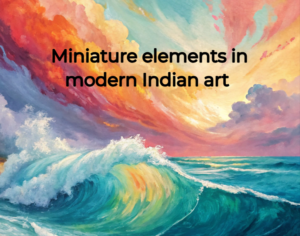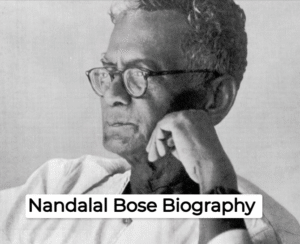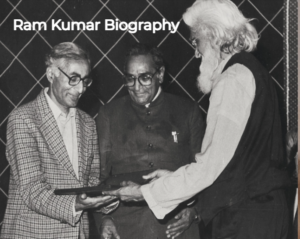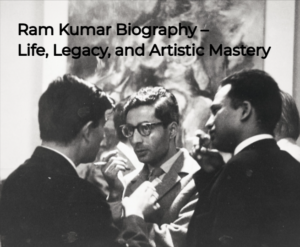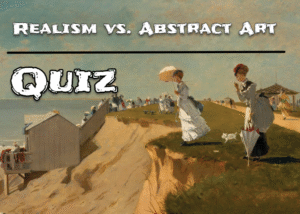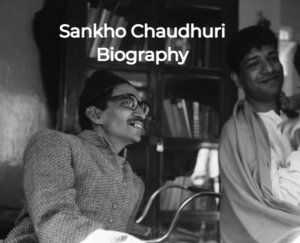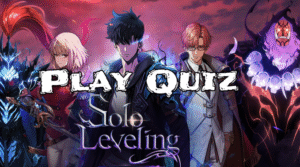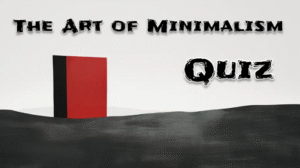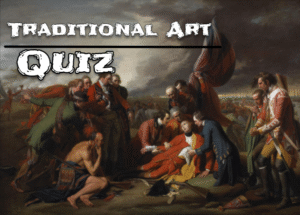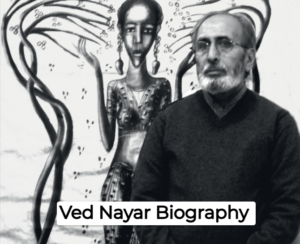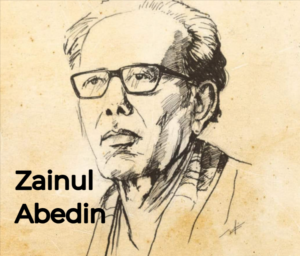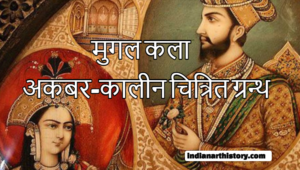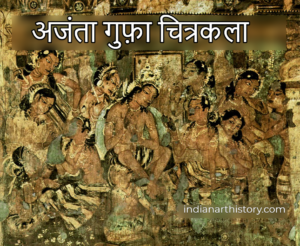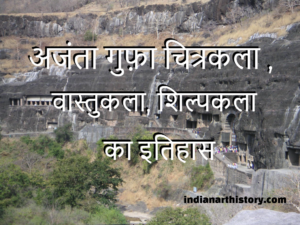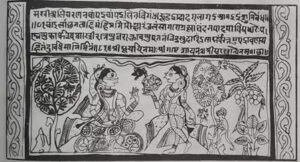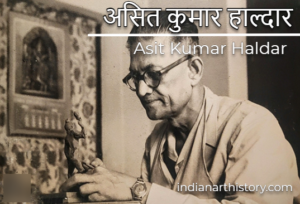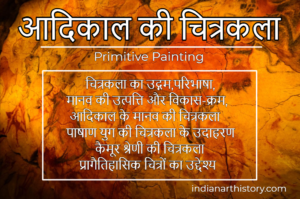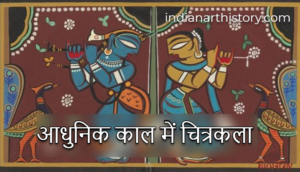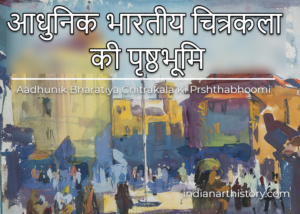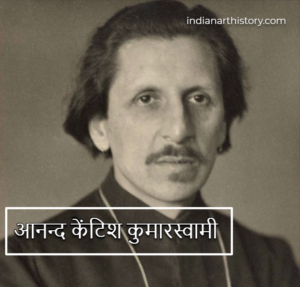Jamini Roy (1887–1972) was a revolutionary Indian artist who redefined modern Indian art by embracing folk traditions and indigenous techniques. His artistic journey was shaped by personal experiences, cultural influences, and a deep desire to create a uniquely Indian art style.
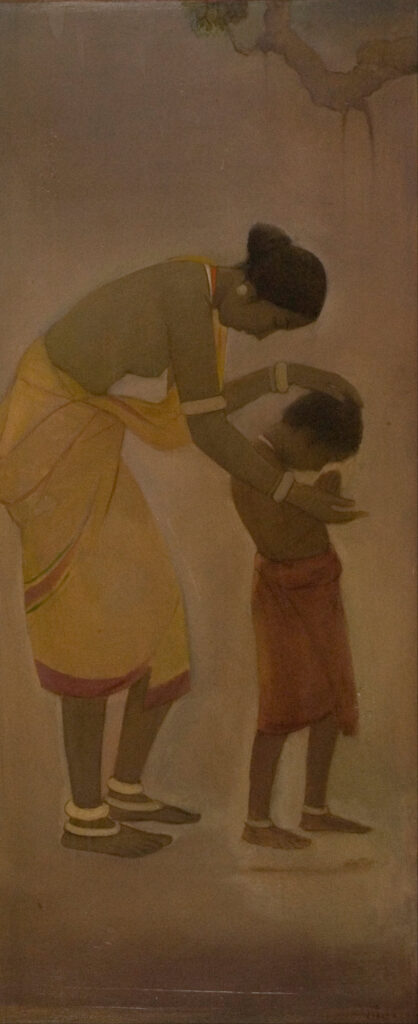
Table of Contents
1. Personal Influences on Jamini Roy
A. Childhood and Early Life (1887–1903)
- Born in Beliatore, Bankura district, Bengal, in a rural setting surrounded by folk traditions.
- Grew up observing Bengali patachitra (scroll paintings) and terracotta temple art.
- His love for simple, bold, and expressive forms developed early due to these influences.
B. Art Education and Western Influence (1903–1916)
- Enrolled in Government College of Art & Craft, Kolkata in 1903, where he trained under European academic styles.
- Initially painted portraits, landscapes, and impressionist-style works inspired by Western masters like Rembrandt and Van Gogh.
C. Shift to Indian Folk Art (1920s–1930s)
- Realized that Western-style painting did not resonate with Indian identity.
- Began exploring Kalighat paintings, Ajanta cave murals, and Bengali folk art.
- Abandoned oil paints and canvas, choosing tempera on cloth, board, and handmade paper.
D. Political and Nationalist Influence (1930s–1940s)
- Inspired by the Swadeshi movement, which encouraged Indians to embrace their own culture.
- His rejection of Western artistic norms was a statement of cultural pride and nationalism.
- Created accessible art that depicted Indian villagers, tribal life, and Hindu mythology.
2. Artistic Journey: Phases of His Work
| Period | Artistic Phase | Key Features |
|---|---|---|
| 1903–1916 | Western Academic Style | Realistic portraits and landscapes |
| 1920s | Shift to Indian Folk Art | Kalighat paintings, simple forms |
| 1930s | Folk-Inspired Modern Art | Bold lines, limited colors, rural themes |
| 1940s | Religious and Mythological Art | Ramayana, Krishna, Radha themes |
| 1950s–1960s | Refinement and Mass Appeal | Minimalist, affordable artworks |
- Recurring Themes: Hindu deities, Bengali rural life, mother-child relationships, tribal culture.
- Signature Style: Bold outlines, flat two-dimensional figures, expressive eyes, limited earthy colors.
3. Major Exhibitions and Recognition
A. National and International Recognition
- First solo exhibition (1938): Indian Society of Oriental Art, Kolkata.
- International Exhibitions (1940s–1950s): His works were displayed in London, New York, and Paris.
- Government Recognition: Awarded the Padma Bhushan in 1954 for his contribution to Indian art.
B. Exhibitions in Major Museums
Today, Jamini Roy’s paintings are part of prestigious collections worldwide:
- National Gallery of Modern Art (NGMA), New Delhi
- Victoria and Albert Museum, London
- Museum of Asian Art, Berlin
- Private Art Collections and Galleries Worldwide
C. Commercial and Popular Appeal
- His paintings were made in multiple versions so more people could afford them.
- Many of his works were replicated on posters, book covers, textiles, and home décor.
- Today, his original works are highly valuable, selling for millions in art auctions.
4. Conclusion: A Lasting Legacy
Jamini Roy’s artistic journey was one of self-discovery, cultural pride, and reinvention. He transformed folk art into modern art, making it accessible, affordable, and deeply Indian.
His legacy continues to inspire contemporary artists, illustrators, and designers worldwide. His paintings remain a symbol of Indian heritage, proving that true art is timeless.
Read More:
- One Piece Quiz
 One Piece Quiz Restart Quiz let currentQuestion = 0; let score = 0; const quizContainer …
One Piece Quiz Restart Quiz let currentQuestion = 0; let score = 0; const quizContainer … - ‘काँगड़ा’ चित्र-शैली की विषयवस्तु तथा विशेषतायें
 ‘काँगड़ा’ चित्र-शैली का परिचय बाह्य रूप से समस्त पहाड़ी कला ‘काँगड़ा’ के नाम से अभिहित …
‘काँगड़ा’ चित्र-शैली का परिचय बाह्य रूप से समस्त पहाड़ी कला ‘काँगड़ा’ के नाम से अभिहित … - 12 Best Material For Outdoor Countertop
 Are you looking for the best material for outdoor countertops? If yes then you are …
Are you looking for the best material for outdoor countertops? If yes then you are … - A R Chughtai | Biography | Life | Paintings
 A R Chughtai (1899-1975) The last artist of the Chughtai family, Mohd. Abdul Rehman Chughtai, …
A R Chughtai (1899-1975) The last artist of the Chughtai family, Mohd. Abdul Rehman Chughtai, … - Abindranath Tagore: The Painter’s Perspective
 Abanindranath Tagore, a renowned artist and member of the prestigious Tagore family, left an indelible …
Abanindranath Tagore, a renowned artist and member of the prestigious Tagore family, left an indelible … - Ajanta Cave Paintings (MCQs)
 100 multiple choice questions (MCQs) about Ajanta Cave Paintings, divided into categories 🏛️ General Information 🕰️ Historical Context 🖌️ Art …
100 multiple choice questions (MCQs) about Ajanta Cave Paintings, divided into categories 🏛️ General Information 🕰️ Historical Context 🖌️ Art … - Aluminum or Steel: Which is Better For Outdoor Furniture
 Summer is almost here. As the sun shines bright and warm, many homeowners want outdoor …
Summer is almost here. As the sun shines bright and warm, many homeowners want outdoor … - Amar Nath Sehgal Biography, Childhood, Life, Artworks, Media, Awards, Exhibitions, Career + Legacy Guide + Top 15 Insights
 Amar Nath Sehgal (b. 1922) A philosopher, poet, artist and craftsman, Amar Nath Sehgal’s unique …
Amar Nath Sehgal (b. 1922) A philosopher, poet, artist and craftsman, Amar Nath Sehgal’s unique … - Amrita Sher-Gil | Biography | Life | Paintings
 Amrita Sher-Gil (1913-41) Amrita Sher-Gil was born of a Hungarian mother and a Sikh father. Amrita …
Amrita Sher-Gil (1913-41) Amrita Sher-Gil was born of a Hungarian mother and a Sikh father. Amrita … - Anupam Sud Biography | Life, artworks
 Anupam Sud (b.1944) Anupam Sud, an outstanding graphist, has adopted printmaking, not only for artistic …
Anupam Sud (b.1944) Anupam Sud, an outstanding graphist, has adopted printmaking, not only for artistic … - Anupam Sud Biography: Untold Legacy & 15 Insightful Facts About the Iconic Printmaker
 Anupam Sud Biography explores the life, legacy, and powerful impact of one of India’s most …
Anupam Sud Biography explores the life, legacy, and powerful impact of one of India’s most … - Anupam Sud’s Contribution to Women in Art
 Anupam Sud holds a unique and powerful place in the history of Indian art, particularly …
Anupam Sud holds a unique and powerful place in the history of Indian art, particularly … - Architectural Backgrounds in Indian Miniature Art Style
 Explore the beauty of architectural backgrounds in Indian miniature art style, their historical significance, techniques, …
Explore the beauty of architectural backgrounds in Indian miniature art style, their historical significance, techniques, … - Art — An Introduction
 What is Art — An Introduction (Indian Context) Art is a technique to complete work …
What is Art — An Introduction (Indian Context) Art is a technique to complete work … - Attack On Titan Quiz
 Attack on Titan Quiz Restart Quiz let currentQuestion = 0; let score = 0; const …
Attack on Titan Quiz Restart Quiz let currentQuestion = 0; let score = 0; const … - Best Fabric for Outdoor Furniture
 These days, folks are using outside spaces like patios as work spots. Due to quarantines, …
These days, folks are using outside spaces like patios as work spots. Due to quarantines, … - Best Material for Garden Furniture
 Are you looking for the best material for garden furniture? If yes then you are …
Are you looking for the best material for garden furniture? If yes then you are … - Best Outdoor Furniture Material For Rain
 Are you looking for the best outdoor furniture material for rain? If yes then you …
Are you looking for the best outdoor furniture material for rain? If yes then you … - Binod Bihari Mukharji
 Binod Bihari, who also had literary interests possessed an intellectual curiosity that led to an analytical …
Binod Bihari, who also had literary interests possessed an intellectual curiosity that led to an analytical … - Blox Fruits Quiz
 Blox Fruits Quiz NEXT RESTART QUIZ let currentQuestion = 0; let score = 0; const …
Blox Fruits Quiz NEXT RESTART QUIZ let currentQuestion = 0; let score = 0; const … - Blox Fruits Quiz
 Blox Fruits Quiz Restart Quiz let currentQuestion = 0; let score = 0; const quizContainer …
Blox Fruits Quiz Restart Quiz let currentQuestion = 0; let score = 0; const quizContainer … - Cave painting | गुफ़ा चित्र
 गुहा चित्रण (जोगीमारा, अजन्ता, बाघ, बादामी, एलोरा, सित्तनवासल इत्यादि) जोगीमारा गुफाएँ Read More About Famous …
गुहा चित्रण (जोगीमारा, अजन्ता, बाघ, बादामी, एलोरा, सित्तनवासल इत्यादि) जोगीमारा गुफाएँ Read More About Famous … - Characteristics of Ellora Paintings
 Ellora Paintings It is called Verulleni or Verul Caves in Marathi which is only 9 …
Ellora Paintings It is called Verulleni or Verul Caves in Marathi which is only 9 … - F.N. Souza Biography | Life, Artworks
 F.N. Souza has produced an imaginative body of figurative paintings that are independent of any …
F.N. Souza has produced an imaginative body of figurative paintings that are independent of any … - F.N. Souza Biography: Life, Art, and Legacy of a Modernist Rebel
 Introduction Ever heard of an artist who painted saints and sinners with the same passion? …
Introduction Ever heard of an artist who painted saints and sinners with the same passion? … - Gaganendranath Tagore Biography | Life, Paintings
 Gaganendranath Tagore (1867-1938) Gaganendranath Tagore, eldest brother of Abanindranath Tagore, was only seventeen years of …
Gaganendranath Tagore (1867-1938) Gaganendranath Tagore, eldest brother of Abanindranath Tagore, was only seventeen years of … - Gaming Characters Quiz
 Gaming Characters Quiz Restart Quiz let currentQuestion = 0; let score = 0; const quizContainer …
Gaming Characters Quiz Restart Quiz let currentQuestion = 0; let score = 0; const quizContainer … - GK Quiz
 Modern Art Quiz Restart Quiz // Additional 15 questions on Modern Art { question: “Who …
Modern Art Quiz Restart Quiz // Additional 15 questions on Modern Art { question: “Who … - Gopal Ghosh Biography | गोपाल घोष (1913-1980)
 आधुनिक भारतीय कलाकारों में रोमाण्टिक के रूप में प्रतिष्ठित कलाकार गोपाल घोष का जन्म 1913 …
आधुनिक भारतीय कलाकारों में रोमाण्टिक के रूप में प्रतिष्ठित कलाकार गोपाल घोष का जन्म 1913 … - Historical Art Quiz
 Historical Art Quiz Restart Quiz let currentQuestion = 0; let score = 0; const quizContainer …
Historical Art Quiz Restart Quiz let currentQuestion = 0; let score = 0; const quizContainer … - How Art Reflects Society and Culture Quiz
 How Art Reflects Society and Culture Quiz Restart Quiz let currentQuestion = 0; let score …
How Art Reflects Society and Culture Quiz Restart Quiz let currentQuestion = 0; let score … - How To Choose Best Material for Outdoor Furniture?
 Are you looking for the best material for outdoor furniture? If yes then you are …
Are you looking for the best material for outdoor furniture? If yes then you are … - How to Identify an Original Jamini Roy Painting
 Jamini Roy’s paintings are highly valuable, and many forgeries exist in the market. If you’re …
Jamini Roy’s paintings are highly valuable, and many forgeries exist in the market. If you’re … - How Well Do You Know Amrita Sher-Gil?
 Quiz: How Well Do You Know Amrita Sher-Gil? Start Quiz Next Your Score: /20 Restart …
Quiz: How Well Do You Know Amrita Sher-Gil? Start Quiz Next Your Score: /20 Restart … - How Well Do You Know Amrita Sher-Gil?
 Question 1 Amrita Sher-Gil is known as:A) The Queen of Mughal ArtB) The Pioneer of …
Question 1 Amrita Sher-Gil is known as:A) The Queen of Mughal ArtB) The Pioneer of … - How Well Do You Know Dragon Ball Z | Quiz
 Dragon Ball Z Quiz Restart Quiz let currentQuestion = 0; let score = 0; const …
Dragon Ball Z Quiz Restart Quiz let currentQuestion = 0; let score = 0; const … - How Well Do You Know Naruto Uzumaki
 Naruto Quiz Restart Quiz let currentQuestion = 0; let score = 0; const quizContainer = …
Naruto Quiz Restart Quiz let currentQuestion = 0; let score = 0; const quizContainer = … - Impressionism
 The first important movement of modern painting in Europe is Impressionism. It was mainly prevalent …
The first important movement of modern painting in Europe is Impressionism. It was mainly prevalent … - Indian Woman Water Colour Painting FREE | Indian Woman Water Colour Digital Art Print FREE
 Download Water color Art For Free
Download Water color Art For Free - Jamini Roy Biography | Life and Paintings
 Jamini Roy (1887-1972) As early as the 1930s, Jamini Roy had anticipated the current vogue …
Jamini Roy (1887-1972) As early as the 1930s, Jamini Roy had anticipated the current vogue … - Jamini Roy: Life, Legacy, and Notable Works
 Jamini Roy (1887–1972) was a pioneering modern Indian artist known for his rejection of Western …
Jamini Roy (1887–1972) was a pioneering modern Indian artist known for his rejection of Western … - Jamini Roy: Personal Influences, Artistic Journey, and Exhibitions
 Jamini Roy (1887–1972) was a revolutionary Indian artist who redefined modern Indian art by embracing …
Jamini Roy (1887–1972) was a revolutionary Indian artist who redefined modern Indian art by embracing … - Jamini Roy’s Artistic Techniques and Influences
 Jamini Roy (1887–1972) is one of India’s most celebrated modern artists. His work was deeply …
Jamini Roy (1887–1972) is one of India’s most celebrated modern artists. His work was deeply … - Jamini Roy’s Influence on Modern Art Movements and a Detailed Look at His Iconic Paintings
 Jamini Roy (1887–1972) was a revolutionary artist who transformed Indian modern art by embracing folk …
Jamini Roy (1887–1972) was a revolutionary artist who transformed Indian modern art by embracing folk … - Jamini Roy’s Influence on Modern Indian Art and Notable Paintings
 Jamini Roy (1887–1972) is one of the most influential figures in modern Indian art. His …
Jamini Roy (1887–1972) is one of the most influential figures in modern Indian art. His … - Jamini Roy’s Notable Paintings and Artistic Techniques
 Jamini Roy (1887–1972) is known for his bold, simplified figures, strong black outlines, and earthy …
Jamini Roy (1887–1972) is known for his bold, simplified figures, strong black outlines, and earthy … - Jamini Roy’s Painting Techniques and the Value of His Art Today
 Jamini Roy (1887–1972) revolutionized modern Indian art by incorporating folk traditions, bold colors, and simplified …
Jamini Roy (1887–1972) revolutionized modern Indian art by incorporating folk traditions, bold colors, and simplified … - K. G. Subramanyan Biography
 K.G. Subramanyan, a prolific contemporary artist, was a painter, a muralist, designer, printmaker, toymaker, weaver and also …
K.G. Subramanyan, a prolific contemporary artist, was a painter, a muralist, designer, printmaker, toymaker, weaver and also … - Krishen Khanna Biography
 Krishen Khanna is known for his figurative approach. His later paintings around (1990) are revolutionary …
Krishen Khanna is known for his figurative approach. His later paintings around (1990) are revolutionary … - Location Tracker App: Just Enter a Mobile Number and See Anyone’s Live Location—Right on Your Phone!
 Learn how to use Google Maps as a free Location Tracker App—no subscription, zero cost, …
Learn how to use Google Maps as a free Location Tracker App—no subscription, zero cost, … - Longest Lasting Outdoor Furniture Material
 Are you looking for the longest-lasting outdoor furniture material? If yes then you are at …
Are you looking for the longest-lasting outdoor furniture material? If yes then you are at … - M.F. Husain Biography | Controversy, Paintings
 M.F. Husain 1915-2010 M. F. Husain has become the symbol of modern Indian art with …
M.F. Husain 1915-2010 M. F. Husain has become the symbol of modern Indian art with … - MF Hussain Painting and Madhuri Dixit: A Captivating Fusion of Art and Bollywood
 Explore the iconic MF Hussain paintings of Madhuri Dixit and the deep artistic connection between …
Explore the iconic MF Hussain paintings of Madhuri Dixit and the deep artistic connection between … - Mine Craft Quiz
 Minecraft Quiz NEXT RESTART QUIZ NEXT: Mine Craft Quiz Can You Name These Iconic Actors?
Minecraft Quiz NEXT RESTART QUIZ NEXT: Mine Craft Quiz Can You Name These Iconic Actors? - Miniature elements in modern Indian art
 Miniature is a beautiful step of medieval Indian painting. The paintings that started first on …
Miniature is a beautiful step of medieval Indian painting. The paintings that started first on … - Most Comfortable Outdoor Chair
 At times, sitting in a nice chair outdoors on a sunny day can be a …
At times, sitting in a nice chair outdoors on a sunny day can be a … - Most Durable Material For Outdoor Furniture
 Are you looking for the most durable material for outdoor furniture? If yes then please …
Are you looking for the most durable material for outdoor furniture? If yes then please … - Nandalal Bose Biography | Life, Paintings
 Nandalal Bose (1882-1966) Even as a young student at the Khudiram Bose’s Central Collegiate School, …
Nandalal Bose (1882-1966) Even as a young student at the Khudiram Bose’s Central Collegiate School, … - Powder Coated Steel Outdoor Furniture
 Do you want a fashionable and comfortable outdoor space that will last long? Are you …
Do you want a fashionable and comfortable outdoor space that will last long? Are you … - Pran Nath Mago Biography
 A painter, designer, art educationist, and art critic, Mago retired as a professor in fine …
A painter, designer, art educationist, and art critic, Mago retired as a professor in fine … - QUIZ: Can You Name These Iconic Actors?Start Quiz Archive Photos/Getty Images Are you an expert on Hollywood’s leading men? We’re going …
- Raja Ravi Varma: A Master of Indian Art and His Lasting Legacy
 Introduction Raja Ravi Varma is one of India’s most celebrated painters, known for his fusion …
Introduction Raja Ravi Varma is one of India’s most celebrated painters, known for his fusion … - Ram Kumar
 Ram Kumar, an important landscape painter, studied under Andre Lhote and Fernand Leger, and has …
Ram Kumar, an important landscape painter, studied under Andre Lhote and Fernand Leger, and has … - Ram Kumar Biography – Life, Legacy, and Artistic Mastery
 Introduction to Ram Kumar: The Visionary Indian Artist Ram Kumar stands as a towering figure …
Introduction to Ram Kumar: The Visionary Indian Artist Ram Kumar stands as a towering figure … - Realism vs. Abstract Art | Quiz
 Realism vs. Abstract Art Quiz Restart Quiz let currentQuestion = 0; let score = 0; …
Realism vs. Abstract Art Quiz Restart Quiz let currentQuestion = 0; let score = 0; … - Sankho Chaudhuri Biography | Life Artworks
 Sankho Chaudhuri (b.1916) Sankho Chaudhuri is n product Of a period in our history in …
Sankho Chaudhuri (b.1916) Sankho Chaudhuri is n product Of a period in our history in … - Solo Leveling Quiz
 Solo Leveling Quiz Restart Quiz let currentQuestion = 0; let score = 0; const quizContainer …
Solo Leveling Quiz Restart Quiz let currentQuestion = 0; let score = 0; const quizContainer … - Steel Outdoor Furniture
 People like to use their backyard or patio as another room when it’s warm outside. …
People like to use their backyard or patio as another room when it’s warm outside. … - Steel Outdoor Patio Furniture
 The patio is truly something else. It is a fantastic space for lounging, eating in …
The patio is truly something else. It is a fantastic space for lounging, eating in … - The Art of Minimalism | Quiz
 The Art of Minimalism Quiz Restart Quiz let currentQuestion = 0; let score = 0; …
The Art of Minimalism Quiz Restart Quiz let currentQuestion = 0; let score = 0; … - the Basics of USA InsuranceLearn the basics of USA insurance, including types, benefits, and how it works. This guide …
- The Role of Art in Mental Health and Therapy Quiz
 The Role of Art in Mental Health and Therapy Quiz Restart Quiz let currentQuestion = …
The Role of Art in Mental Health and Therapy Quiz Restart Quiz let currentQuestion = … - The Ultimate Guide to USA Insurance: Everything You Need to KnowLooking for comprehensive USA Insurance information? Friends, let’s talk about the different types of insurance, …
- The Ultimate Guide to USA Insurance: Everything You Need to KnowLooking for comprehensive USA Insurance information? Friends, let’s talk about the different types of insurance, …
- Traditional Art Quiz
 Traditional Art Quiz Restart Quiz let currentQuestion = 0; let score = 0; const quizContainer …
Traditional Art Quiz Restart Quiz let currentQuestion = 0; let score = 0; const quizContainer … - Tyeb Mehta
 Tyeb Mehta Biography: Untold Journey of India’s Modern Art Pioneer Introduction to Tyeb Mehta The …
Tyeb Mehta Biography: Untold Journey of India’s Modern Art Pioneer Introduction to Tyeb Mehta The … - Types of Outdoor Furniture Material
 Are you wondering what are the types of outdoor furniture materials? If yes then you …
Are you wondering what are the types of outdoor furniture materials? If yes then you … - Ved Nayar Biography | Life, artworks
 Ved Nayar (b.1933) With the spread of installation art in the 1990s, there has been …
Ved Nayar (b.1933) With the spread of installation art in the 1990s, there has been … - What is Kate Moss’s Net Worth? Everything You Need to Know About the Supermodel’s Wealth
 What is Kate Moss’s net worth? Discover everything about the supermodel’s financial empire, income sources, …
What is Kate Moss’s net worth? Discover everything about the supermodel’s financial empire, income sources, … - What is the art style of Ram Kumar?
 Ram Kumar (1924–2018) was a prominent Indian artist whose work evolved significantly over his career, …
Ram Kumar (1924–2018) was a prominent Indian artist whose work evolved significantly over his career, … - What Is The Best Material for Patio Furniture?
 Are you looking for the best material for patio furniture? If yes then you are …
Are you looking for the best material for patio furniture? If yes then you are … - World’s Most Beautiful Women
 Beauty, an intricate tapestry woven from physical allure, charisma, talent, and influence, transcends mere appearance. …
Beauty, an intricate tapestry woven from physical allure, charisma, talent, and influence, transcends mere appearance. … - Zainul Abedin Biography | Life, Paintings
 Zainul Abedin (1917-1976) According to Nazrul Islam, the great revolutionary poet of Bengal, the significance …
Zainul Abedin (1917-1976) According to Nazrul Islam, the great revolutionary poet of Bengal, the significance … - अ० अ० आलमेलकर | Abdul Rahim Appa Bhai Alamelkarअब्दुल रहीम अप्पा भाई आलमेलकर का जन्म अहमदाबाद में हुआ था। बचपन से ही उन्हें चित्रकला …
- अकबर-कालीन चित्रित ग्रन्थ
 अकबर काल में कला अकबर- 1557 ई० में अकबर अपने पिता हुमायूँ की मृत्यु के …
अकबर काल में कला अकबर- 1557 ई० में अकबर अपने पिता हुमायूँ की मृत्यु के … - अजंता की मुख्य गुफाओं के चित्र
 अजंता की मुख्य गुफाओं के चित्र,अजन्ता में चैत्य और बिहार दोनों प्रकार की 30 गुफायें हैं। इनमें गुफा संख्या 1, 2, 6, 7, 9, 10, 11,15, 16, 17, 19, 20, 21 व 22 में चित्र बने थे। आज केवल गुफा संख्या 1, 2, 9, 10, 16 व 17 चित्रों से मुख्य रूप से सुसज्जित है तथा यहीं अधिकांश चित्र सुरक्षित है।
अजंता की मुख्य गुफाओं के चित्र,अजन्ता में चैत्य और बिहार दोनों प्रकार की 30 गुफायें हैं। इनमें गुफा संख्या 1, 2, 6, 7, 9, 10, 11,15, 16, 17, 19, 20, 21 व 22 में चित्र बने थे। आज केवल गुफा संख्या 1, 2, 9, 10, 16 व 17 चित्रों से मुख्य रूप से सुसज्जित है तथा यहीं अधिकांश चित्र सुरक्षित है। - अजंता गुफ़ा चित्रकला
 अजंता चित्रकला महाराष्ट्र के औरंगाबाद ज़िले में सह्याद्रि की पहाड़ियों में स्थित अजंता में कुल …
अजंता चित्रकला महाराष्ट्र के औरंगाबाद ज़िले में सह्याद्रि की पहाड़ियों में स्थित अजंता में कुल … - अजंता गुफाओं की संख्या, चित्रकला,निर्माण काल और अजन्ता चित्र शैली की विशेषताएँ | Number of Ajanta Caves, Painting, Construction Period and Characteristics of Ajanta Painting Style
 अजन्ता की गुफाएँ महाराष्ट्र में औरंगाबाद में 68 किलोमीटर दूर पहाड़ियों में विराजमान हैं। जहाँ प्रकृति ने मुक्त हस्त से अपना सौन्दर्य विकीर्ण किया है। प्राय: कलाकार को शोरगुल से दूर शान्तमय वातावरण में चित्रण करना भाता है
अजन्ता की गुफाएँ महाराष्ट्र में औरंगाबाद में 68 किलोमीटर दूर पहाड़ियों में विराजमान हैं। जहाँ प्रकृति ने मुक्त हस्त से अपना सौन्दर्य विकीर्ण किया है। प्राय: कलाकार को शोरगुल से दूर शान्तमय वातावरण में चित्रण करना भाता है - अनुपम सूद | Anupam Sood
 अनुपम सूद का जन्म होशियारपुर में 1944 में हुआ था। उन्होंने कालेज आफ आर्ट दिल्ली …
अनुपम सूद का जन्म होशियारपुर में 1944 में हुआ था। उन्होंने कालेज आफ आर्ट दिल्ली … - अपभ्रंश शैली के चित्र | अपभ्रंश-शैली की प्रमुख विशेषतायें | जैन शैली | गुजराती शैली या पश्चिम भारतीय शैली | ग्रामीण शैली
 श्वेताम्बर जैन धर्म की अनेक सचित्र पोथियाँ 1100 ई० से 1500 ई० के मध्य विशेष …
श्वेताम्बर जैन धर्म की अनेक सचित्र पोथियाँ 1100 ई० से 1500 ई० के मध्य विशेष … - अब्दुर्रहमान चुगताई (1897-1975) वंश परम्परा से ईरानी और जन्म से भारतीय श्री मुहम्मद अब्दुर्रहमान चुगताई अवनीन्द्रनाथ ठाकुर के …
- अभिव्यंजनावाद | भारतीय अभिव्यंजनावाद | Indian Expressionismयूरोप में बीसवीं शती का एक प्रमुख कला आन्दोलन “अभिव्यंजनावाद” के रूप में 1905-06 के …
- अरूपदास | Arupadasअरूपदास का जन्म चिनसुराह में 5 जुलाई 1927 को हुआ था और बचपन इसी सुन्दर …
- अवनीन्द्रनाथ ठाकुरआधुनिक भारतीय चित्रकला आन्दोलन के प्रथम वैतालिक श्री अवनीन्द्रनाथ ठाकुर का जन्म जोडासको नामक स्थान …
- असित कुमार हाल्दार | Asit Kumar Haldar
 श्री असित कुमार हाल्दार में काव्य तथा चित्रकारी दोनों ललित कलाओं का सुन्दर संयोग मिलता …
श्री असित कुमार हाल्दार में काव्य तथा चित्रकारी दोनों ललित कलाओं का सुन्दर संयोग मिलता … - आगोश्तों शोफ्त | Agoston Schofftशोफ्त (1809-1880) हंगेरियन चित्रकार थे। उनके विषय में भारत में बहुत कम जानकारी है। शोफ्त के …
- आदिकाल की चित्रकला | Primitive Painting
 (गुहाओं, कंदराओं, शिलाश्रयों की चित्रकला) (३०,००० ई० पू० से ५० ई० तक) चित्रकला का उद्गम …
(गुहाओं, कंदराओं, शिलाश्रयों की चित्रकला) (३०,००० ई० पू० से ५० ई० तक) चित्रकला का उद्गम … - आधुनिक काल में चित्रकला
 18वीं सदी के अंत और 19वीं सदी की शुरुआत में, चित्रों में अर्द्ध-पश्चिमी स्थानीय शैली …
18वीं सदी के अंत और 19वीं सदी की शुरुआत में, चित्रों में अर्द्ध-पश्चिमी स्थानीय शैली … - आधुनिक भारतीय चित्रकला की पृष्ठभूमि | Aadhunik Bharatiya Chitrakala Ki Prshthabhoomi
 आधुनिक भारतीय चित्रकला का इतिहास एक उलझनपूर्ण किन्तु विकासशील कला का इतिहास है। इसके आरम्भिक सूत्र इस देश …
आधुनिक भारतीय चित्रकला का इतिहास एक उलझनपूर्ण किन्तु विकासशील कला का इतिहास है। इसके आरम्भिक सूत्र इस देश … - आनन्द केण्टिश कुमारस्वामी
 पुनरुत्थान काल में भारतीय कला के प्रमुख प्रशंसक एवं लेखक डा० आनन्द कुमारस्वामी (1877-1947 ई०)- …
पुनरुत्थान काल में भारतीय कला के प्रमुख प्रशंसक एवं लेखक डा० आनन्द कुमारस्वामी (1877-1947 ई०)- …

